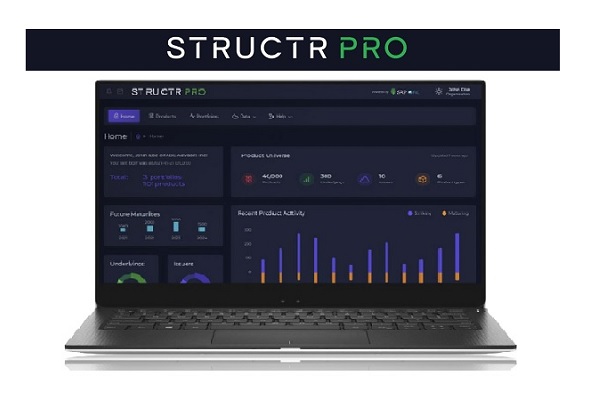The universe of underlyings available to institutional and retail investors is ever growing. This has been driven by greater market understanding, more sophisticated portfolio techniques and a willingness to embrace different approaches. It has also been accelerated by improving systems and technologies to create, hedge and monitor new underlyings. Central to this process is the rapid growth of indices and the ETFs that bring them to market.
Structured products have long taken advantage of a wide variety of underlying assets and indeed this is one of their strengths. The ability to choose between and combine equities, rates and commodities allows structured product manufacturers to create many different solutions. Many products use indices designed for that purpose such as those with volatility control or fixed dividends and decrement.
Additionally structured products can position themselves at different places on the risk spectrum by the choice of option exposure.
Leverage in the underlying not in the payoff
An alternative way to provide different levels of risk to an underlying in a delta one open ended way outside the realm of structured product can also be achieved by the use of leveraged and inverse indices. This idea is relatively simple and has been around for some time. For any index it is possible in principle to create leveraged versions by defining daily exposure to the base index. Investment vehicles such as ETFs can then be launched to track them.
www.Structuredretailproducts.com has recorded over seventy such indices across different asset classes and markets. Most of them are linked to either equity indices or individual stocks. Of these indices, 60 are leveraged and 15 are inverse style. The two most active index providers in this area are iStoxx and ICE.
Leveraged and inverse indices and the corresponding ETFs are intended as short-term investments to take targeted positions in an underlying. Indices reset every day to take account of the market movement and to precisely maintain the desired leverage. Most of these indices are linked to well-known stocks because of demand to take leveraged or short positions if investors have a strong view.
Enhanced regulatory scrutiny
Although leveraged indices are popular with some investors they have also attracted regulatory scrutiny. For example the US regulator FINRA in 2022 in its update of its Notice of Complex Products included many mentions of these indices and funds which had exploded in popularity since the previous notice ten years earlier. It wrote that “A product that combines features of multiple products and strategies also may be complex e.g. leveraged or inverse exchange-traded products (ETPs)—collectively, “geared” ETPs—that can employ futures contracts and other derivatives or may engage in short sales”.
FINRA felt the need to give prominence to the dangers of these types of instruments, not perhaps because they are extremely complex such as long dated products with hard to assess payoff features or credit exposures but because of their popularity, ease of access via broker platforms and the fact that they are used by an investor base which may lack experience or discipline. It is very interesting to note that an unprecedented volume of comments were received (over 16000) on their website, the vast majority of which were from investors objecting to any attempts to limit such investing. Once typical example stating “I oppose restrictions to my right to invest. I, not regulators should be able to choose the public investments that are right for me. Public investments should be available to all of the public, not just the privileged.”
In the UK the Financial Conduct Authority has also put out various ruling on leveraged funds and the related “contract for differences”.
Regulators are wary of such investments for several reasons. Firstly, despite the naming, categorisation and detailed risk warnings that will accompany them, some investors may not appreciate the true nature of the leverage. They often base their decision on press articles or by looking at previous performance in times of market growth when such indices will be amongst the best performers.
Understanding index mechanisms
Secondly, the precise relationship between the leveraged index and its base is not always in proportion. Therefore the behaviour of holding the leveraged index can look quite different to the base index. This is true particularly in times of large moves in either direction and when the cost of the borrowing is taken into account.
Most leveraged indices are 2x, 3x or 5x leveraged. The index with the most number of variations on the SRP list is the CAC40, the French equity index. This has at least six versions, with the highest geared being 15 times the underlying index, the highest gearing of the entire set monitored by SRP.
A comparison of the CAC40, the CACLV (“standard” 2x leveraged version), and the CAC x15 from 2016 to 2020 shows the expected relationship between the three in terms of performance and volatility. During the Covid market crash of 2020 the x15 leveraged version could not cope with the downturn and in fact went to zero and was discontinued. It has since been relaunched from a new base level.
While leveraged and inverse indices are reasonably popular, it would be very difficult for index and ETF providers to offer different levels of leverage across hundreds of underlying assets to satisfy individual investor demand. Some brokerage accounts also allow trading on margin where investors can achieve the same effect, subject to the obvious risks.
There is no compelling reason for leveraged indices to be used within the world of structured products since hedging the mainstream index will allow better direct geared exposure (for example 200% leverage up to a cap) and provide the precise return that the terms of the product will require.
In conclusion, while leveraged and inverse indices are an interesting addition to the investment universe they are intended for short term positions across a limited range of underlyings and exposures. Structured products offer a more flexible and arguably more transparent way to achieve different levels of leverage in a given underlying.
Tags: Stress testingA version of this article has also appeared on www.structuredretailproducts.com













